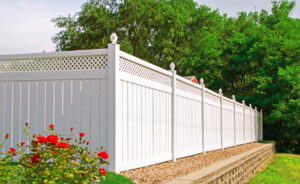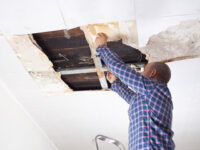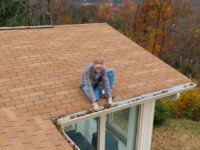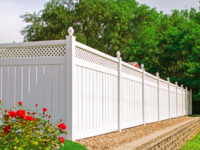Angled Fences for Sloped Yards
 Fences can be tricky to install on sloped ground, but they have the experience and knowledge to create a seamless look with the smallest gaps underneath. Our team will help you choose the best aluminum fence product for your sloped yard based on its length and whether it can be angled.
Fences can be tricky to install on sloped ground, but they have the experience and knowledge to create a seamless look with the smallest gaps underneath. Our team will help you choose the best aluminum fence product for your sloped yard based on its length and whether it can be angled.
Pro Angle Fencing Summerville is an important investment that can help keep children and pets safe and prevent unwanted intruders. However, if your property has a sloped backyard, finding a fence that looks good while meeting all of the functional requirements of the space may be challenging. The most popular fencing options for sloping yards include split rail, picket, and shadowbox fences. Luckily, many of these styles can be customized to fit the specific needs of your yard and slope.
A new development in fence design is rackable panels that can be adjusted to accommodate varying slope degrees. It makes installing a fence on a sloped yard much easier than it used to be. These panels are usually made of wood, but they can be matched to your home’s décor for a more modern look. Another option is a stepped fence that mimics the appearance of stairs, with each section of the wall being slightly higher or lower than the one above it.
The most traditional way to install a fence in a sloped backyard is to build it using the same techniques as a flat yard. It can be very time-consuming and requires careful measurements of the sloped yard to avoid miscalculations. Miscalculations can result in gaps under the bottom of the fence that allow small animals and pets to escape from your yard.
Fortunately, there are several options for homeowners who have sloping yards to consider that will prevent gaps under the fence. One option is a racked fence, often used on Central Texas properties with sloped backyards. The fence posts are plumb (vertical), but the horizontal rails follow the sloping ground to prevent gaps.
This technique is also effective on a smaller scale and can be used for small garden areas that are difficult to fence in with a straight line. This type of fence involves a lot of measuring and cutting, but it can be a cost-effective solution for homeowners looking to create a wall in their sloping backyard. The disadvantage of this method is that it can leave a visible seam in the backyard.
When a beautiful fence frames your yard, it immediately creates a positive impression on passersby. According to the American Society of Landscape Architects, it can boost your home’s value.
Whether you have a wooden or metal fence, you can dress it up with a few simple upgrades to enhance curb appeal. For example, a white picket fence with brightly colored flowers peeking through its slats looks inviting rather than imposing. A well-designed gate is another visual punctuation point that welcomes visitors to your property.
If your fence needs to be in better shape, consider painting it. Several shades of wood, from blonde to dark gray, blend with almost any house paint, says color expert Amy Wax of Your Color Source(link is external) in Montclair, N.J. Many homeowners opt to match the color of their homes, but if that’s too stark for your tastes, try a neutral hue like soft greige or light gray.
Aside from aesthetics, a fence can protect your property and increase privacy. In urban areas, walls provide security and safety for children and pets who might wander away or become vulnerable to passing cars. And a nice-looking fence encourages buyers so that it may be worth the investment.
Residential fencing can range from a traditional white picket to wrought iron or aluminum. The most important element is how well it complements your home and fits the surrounding landscaping. A quality fence just a little short for your property’s setting looks best. Building a more temporary wall in the front yard and a taller one in the backyard is customary for privacy.
If you want to add a more architectural look to your fence, choose a style with arches or panels instead of individual pieces of wood or metal. You can even buy prefabricated sections that are easy to connect and provide a seamless appearance.
To improve the visual impact of your fence, plant flowers and shrubs within its boundaries. These can be a single focal point with a large bloom or an entire border. Or, try a vertical garden with drought-tolerant plants that cling to the sides of your fence, such as a colorful array of herbs or vines.
A privacy fence can be an invaluable asset for your backyard. It blocks out on-lookers and creates a private space to kick back and relax. Several ways to accomplish this goal include adding an angled top rail to your fence. It is a simple and inexpensive way to increase your privacy.
Another option is to add a lattice detail to your fence. This fence style is created with thin slats in an open criss-cross pattern that adds a decorative touch but doesn’t provide complete privacy. Rather than build this type of fence from scratch, you can buy pre-built lattice panels to save time and money.
Consider building a stone wall or masonry fence for a private backyard. These walls are more expensive but can block out prying eyes and sound. They’re also incredibly stable, even in sloped yards. Stone walls can be built as a standalone structure or combined with standard fence materials like wood, PVC, or metal.
To make your fence more private, add a gate or cover it with vines. You can also paint your fence dark, which works especially well for green spaces. Dark shades add depth and contrast to gardens and work well with modern garden plants like tree ferns and banana trees.
Finally, you can also try a double-sided fence. These are made from high-quality materials that look good on both sides of the fence. They’re more expensive than other fences but can block out noise and keep you secluded from neighbors or passersby. This type of fence is most commonly used in townhomes and condominiums where you want to avoid being seen by your neighbors.
High-risk facilities often incorporate angled fences with other security measures to deter intruders. These include barbed wire, razor wire, and various metal security fence components. Specialized anti-terrorism cables are also incorporated into the main structure of these fences. These metal cables have a ‘bend but don’t break’ effect that invasive vehicles and other equipment will have difficulty pushing against.
Another security measure many facilities use is specialized paint applied to the fence’s surface. This paint is slippery long after it has dried, making it difficult for anyone to grip the wall and scale it. Government institutions use these specialized fences to ensure maximum protection for sensitive areas.
Other options for enhancing security on an angled fence include adding a sensor system, lighting, or additional gates. It’s also possible to add a clear zone that will make it impossible for intruders to hide from a designated area. Some of these facilities will even bolt or shear all hex head nuts on the outside of the fence so they can’t be removed with a wrench or other tool. Sometimes, an adhesive like Loctite is also used on the hex head bolts to keep them from being loosened or stripped. It makes the removal of the hex bolts much more difficult and dangerous for would-be intruders.






